Travel with me #97 : The National Palace Museum in Taipei, Taiwan!
Dear Steemit friends :
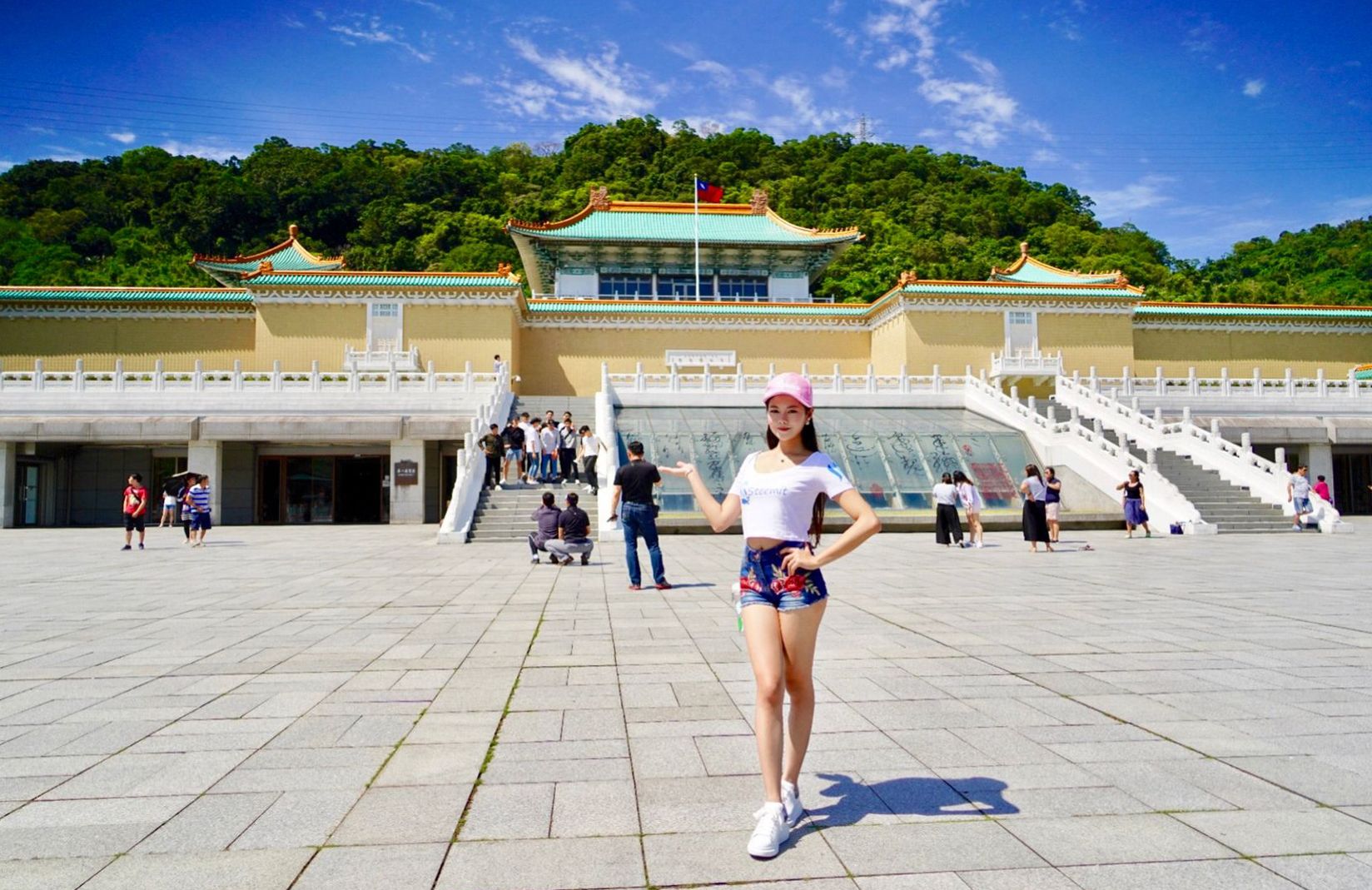
In my recent visit to Taiwan, I had the opportunity to visit the National Palace Museum in Taipei. As a mainland visitor, it was an honour as well as a rare opportunity for me to see these imperial treasures once held inside in The Forbidden City, Beijing.
In Miss. Delicious #78, we visited the museums very own special tea house / restaurant called Silks Palace located at the same site as the museum. There, we familiarised ourselves with the traditional way of drinking tea, as well as treated ourselves to a dim-sum lunch with a very "curio" twist.
For this post, we'll be going inside the museum part of The National Palace Museum, seeing one the largest collections of ancient Chinese artifacts in the world. If you read the post about Silks Palace, then you'll recognise some of the "snacks" from the curio boxes inside the museum, most notably the Jadeite Cabbage. There are countless more priceless artifacts inside the museum, in-fact, roughly 700,000 others, collectively encompassing more than 8000 years of Chinese history.
Some people call the National Palace Museum the Louvre of Asia, and just like it's European counterpart, you could spend several days exploring the National Palace Museum, combing through each of it's galleries in full detail, understanding the foot-prints of each epoch, leading to the significance of the articles on display. For those of you who intend to do that, this post will serve as a teaser, otherwise, let's move on and start checking this place out!
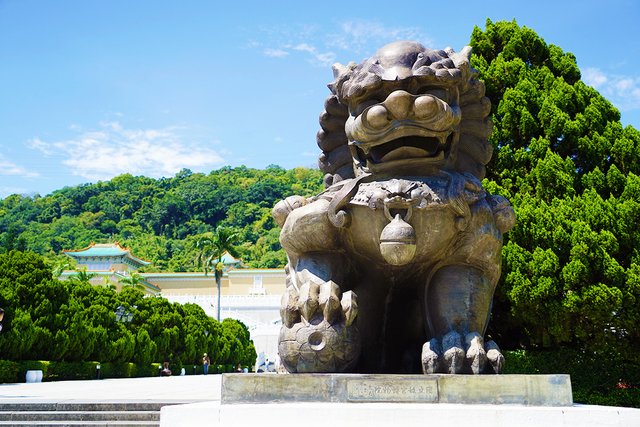
Background and History of the National Palace Museum.
Since my childhood, we have been taught a version of history that paints a mostly negative narrative of Chiang Kai Shek and the Kuomingtang party. In the modern day, ripples of that history continue to affect political relationships between the two nations sharing a common language but fairly different cultural mentality. Although the relationship has improved somewhat in the last 3 decades, the democratized Taiwanese fall in and out of Beijing favour depending on who get's elected to power every couple of years. The relationship strengthens when KMT party is in power, and weakens with the DPP in control. Currently the DPP is in control, and with that, a negative tone between the two has returned. At the peak of the two side's relationship, Taiwan could expect up to 4 million visitors per year from China alone, most of them paying a visit to the National Palace Museum.
Whilst the number of visitors from China has significantly dropped. The museum remains the most popular attraction for those that do make it on to the island. To many, a visit to the NPM is a completion of their visit to the National Palace in Beijing, completing their experience , making it "whole".
Why were the artifacts separated from the National Palace?
During the 1930's, the Japanese threat in the North of China became a growing concern. For fear of losing the national treasures to the Japanese, the management of the Palace Museum in Beijing ordered the majority of the collection to be packed up into crates (20,000 in total) and transported further south to Nanjin. The plan was intercepted by the enemy and the crates were transported to Shanghai instead. There, they stayed for the next eight years whilst the Japanese threat was warded off, world war two ended as well as the Chinese civil war. Chiang Kai-Shek took 22% of the pieces with him to Taiwan in exile, including the Jadeite Cabbage and a large portion of the very best pieces in the collection.
For many years, the partial collection remained in storage with the assumption that CKS would take them back to China. By the 1960's, it became clear that Taiwan would become his permanent home and thus work began on building a museum to exhibit these national treasures.
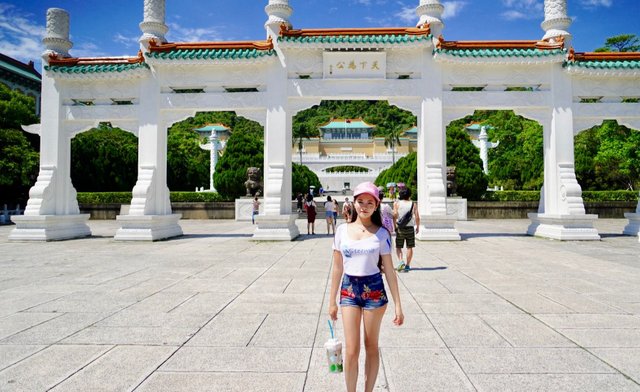
The National Palace Museum was built in the Waishuanxi, Shilin District, well shielded by the local forestation and low mountainous terrain of the area. The first thing you'll notice is that the actual museum building is up against the side of a mountain and a good 5 to 10 minute walk from the start of the entrance.
To reach the main hall, you have to walk through a large Paifang archway, and up a number of steps.
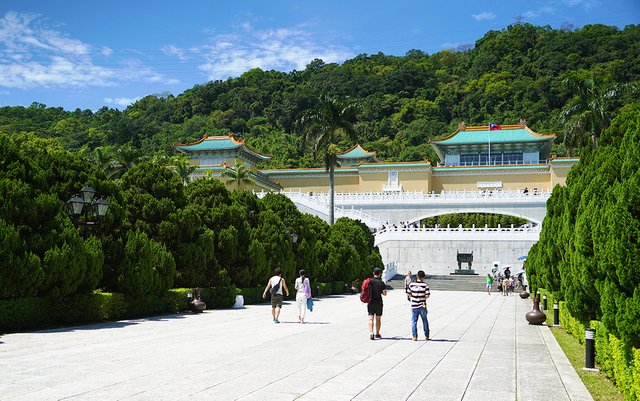
Because the National Palace Museum and the Forbidden City in Beijing are derived from the same institution but later split, the design of the NPM is modelled on the architecture of the Forbidden City, incorporating imperial designs from a feudal society.
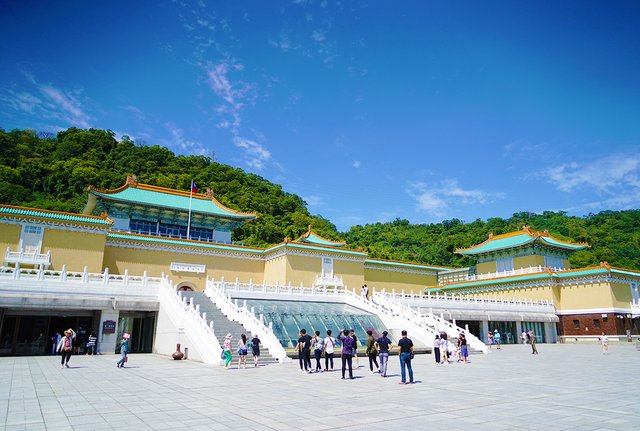
The main building has four floors, three of which are used for exhibitions and one floor is used as a resting lounge.
The sheer number of artifacts brought over from China, as well as a constant supplementation of the collection, has meant that the museum has undergone further expansions several times since it's establishment to create room for more and more exhibits. In-fact, in the year 2000, it was decided that the NPM would expand to a second branch located in Chiayi County. This would later on be known as the Southern Branch, whilst the original would be called the Northern Branch.
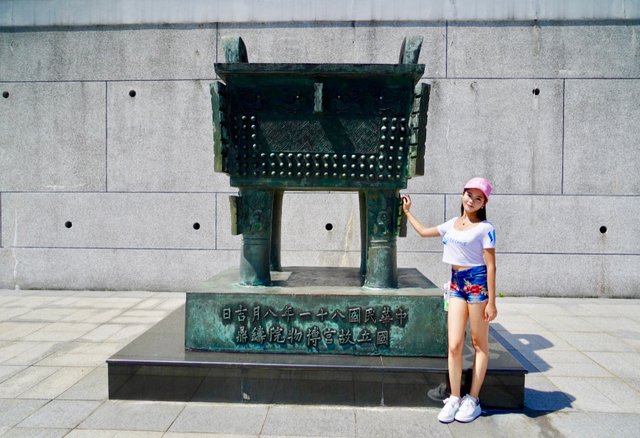
There are some really beautiful views of the traditional looking buildings blending in with the shallow mountain ranges in the background.
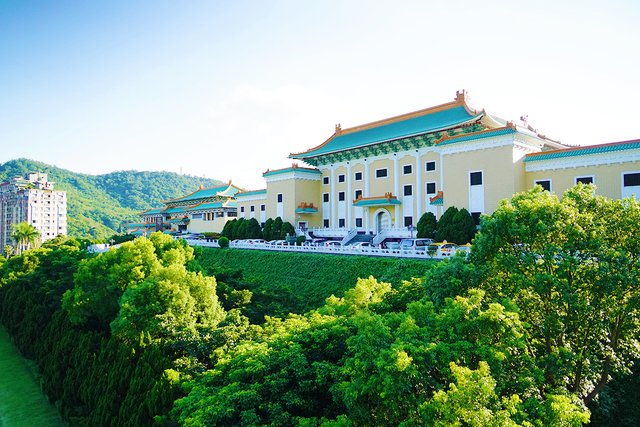
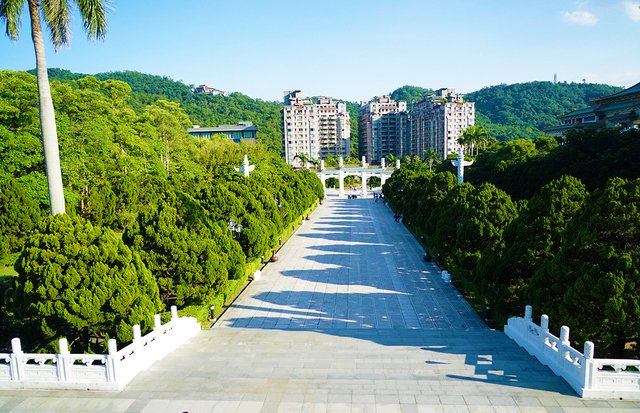
This column is generally referred to as Huabiao, and is a kind of stone pole used for ceremonial purposes. On top, you can see it has the Chinese Guardian Lion. This style of Huabiao is frequently found outside palaces, as such, they have a more specific name called bangmu.
The horizontal wing like stone is actually meant to be a cloud. And the mythical creature above it (in this case the Lion) is meant to communicate the mood of the people below to the heavens above.
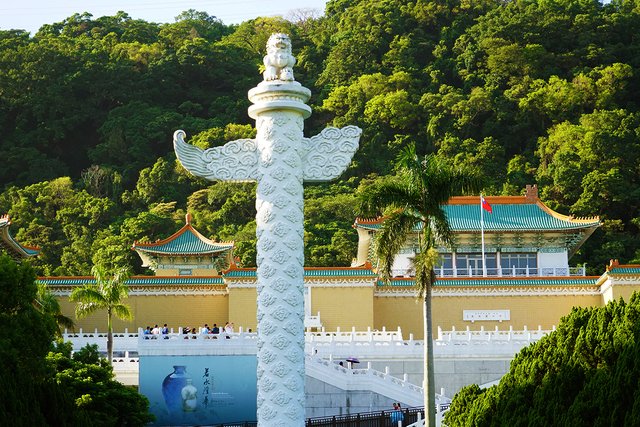
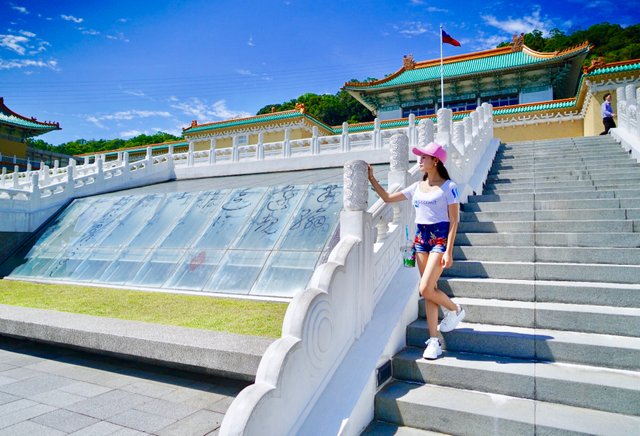
Once inside the main hall, there is a large open space where you'll find the ticket office, souvenir shop, and even a post office. The price of entry is about 250 NT which is about $10 dollars. You can also purchase a guided tour, or borrow an audio guide.
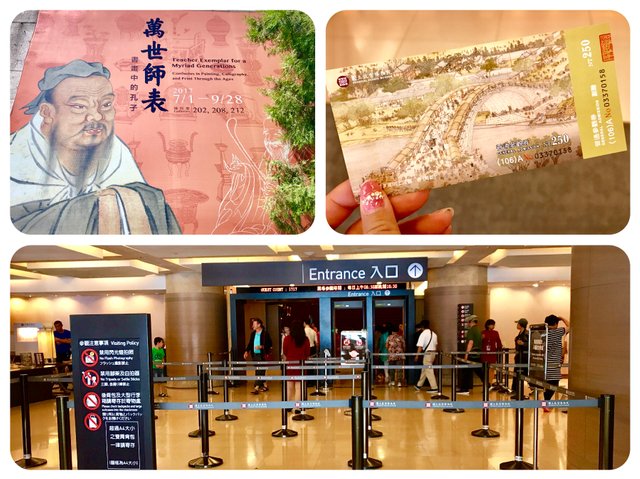
In the lower floor, there is a statue of Dr. Sun Yat-Sen which has been placed there to commemorate his founding of the Republic of China. He is one of the few people in modern Chinese history who is respected by both the people of Taiwan and China. Above his head, you can see the characters "博爱“. These are two of Sun Yat Sen's favourite characters, portraying his life's work. Together, they represent fraternity and concern for the welfare of human beings, a quality which grants him respect by all Chinese people to this day.

Now, it's time to feast your eyes on a few of the objects in the collection which caught my eye. As you can imagine, with hundreds of thousands of items on display, it can take more than just a few days to look through everything. Still, if you know what you're more interested in, then you can pick and choose.
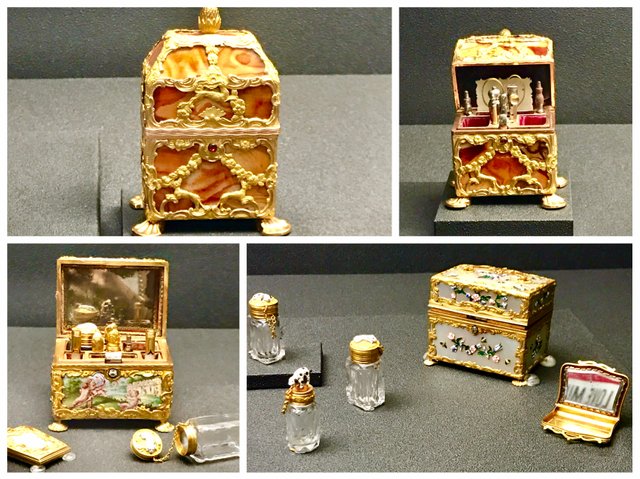
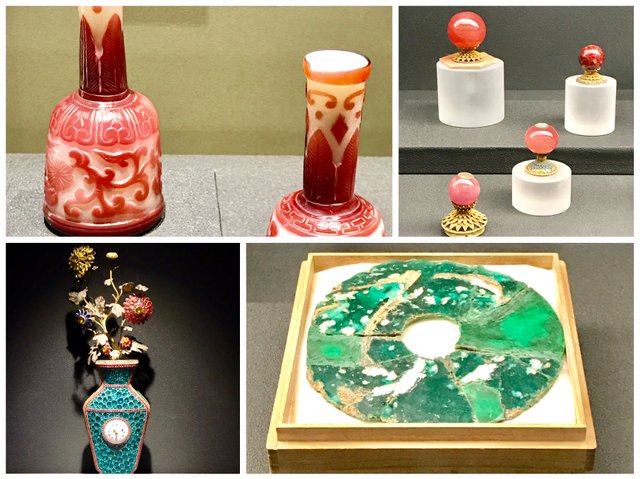
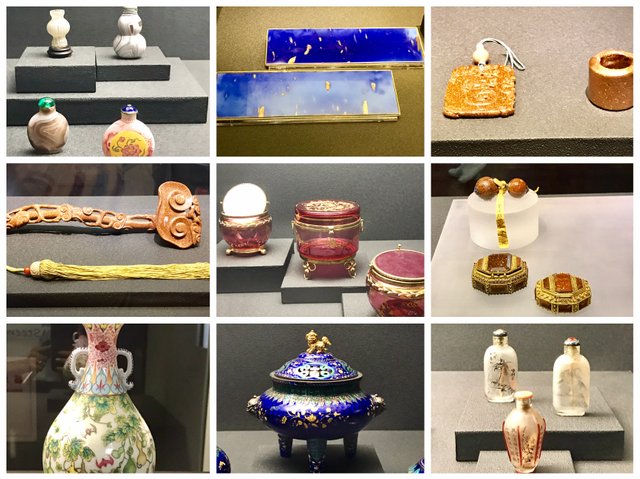
Jade was commonly used for sculptures in the neolithic periods of Chinese history, and is primarily considered a form of decorative art. Many sculptors would spend a life time learning how to create incredibly intricate and detailed sculptures. These are some of the better ones I saw.

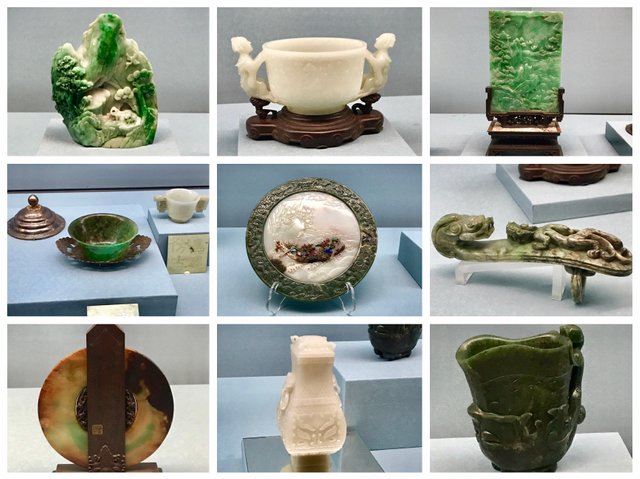


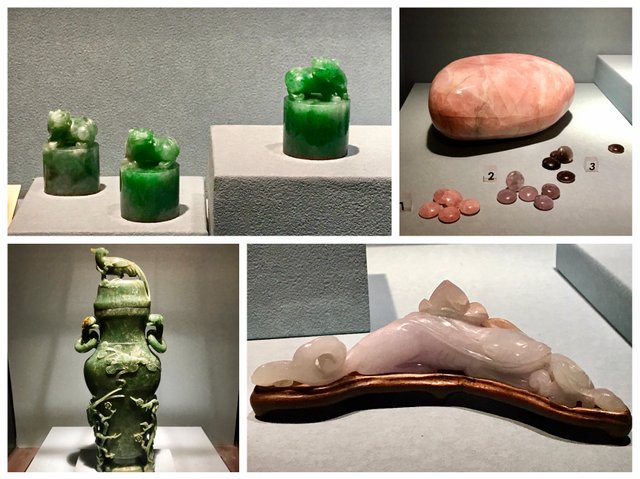
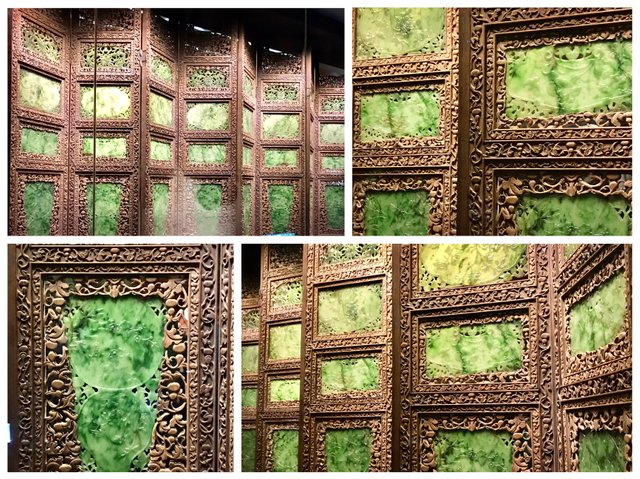
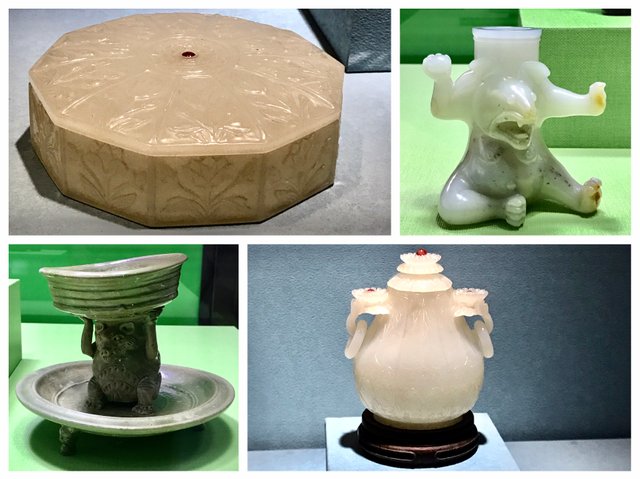
Ceramics are a focal point of Chinese art development. The first examples of Chinese ceramics date back as far as the Palaeolithic area. The examples in this museum are the imperial court porcelain wares which are each handmade by the best potters of their time.
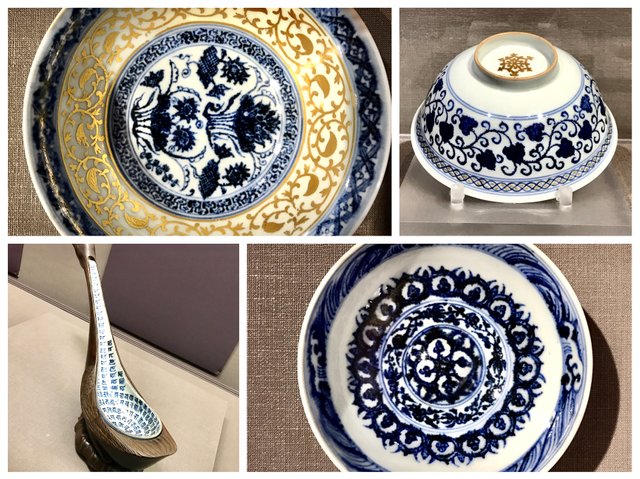

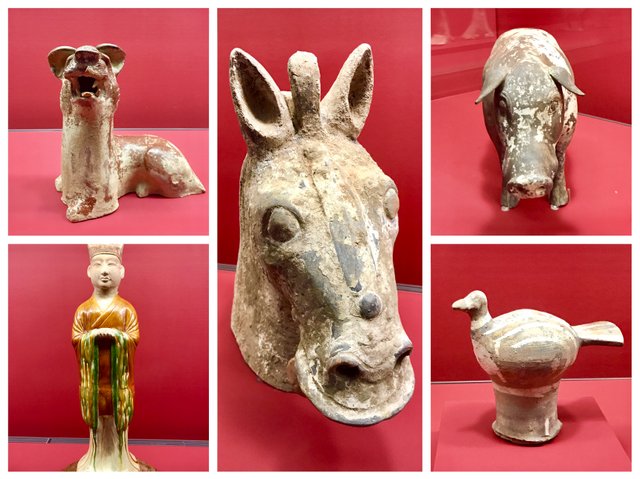
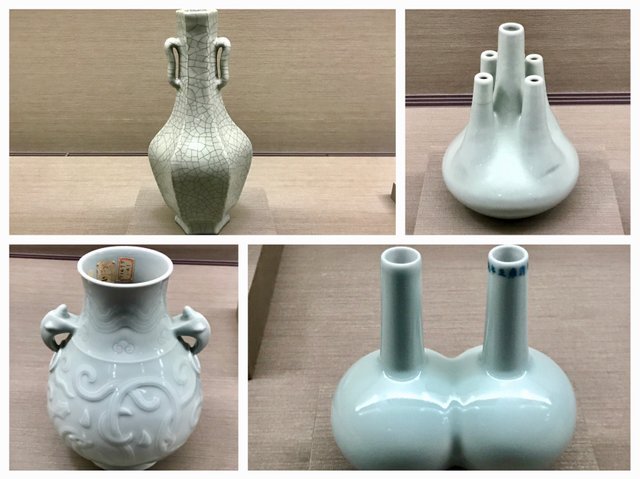
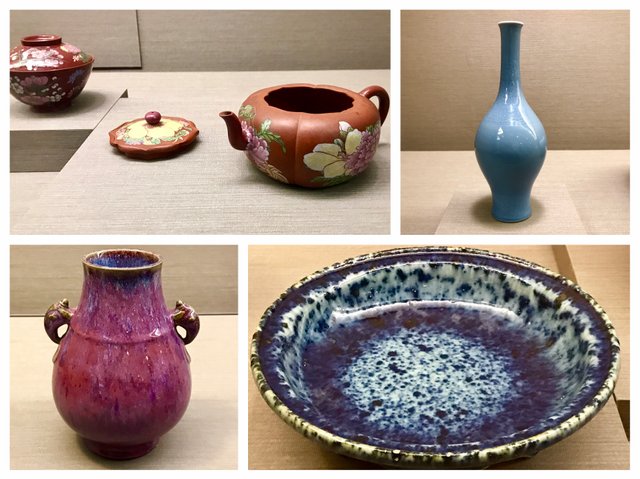
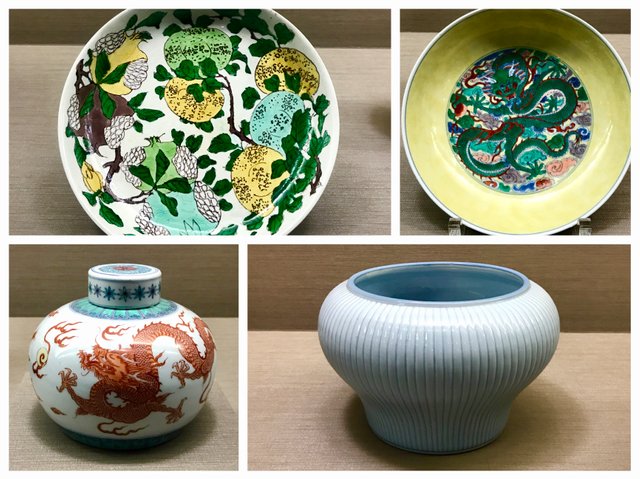




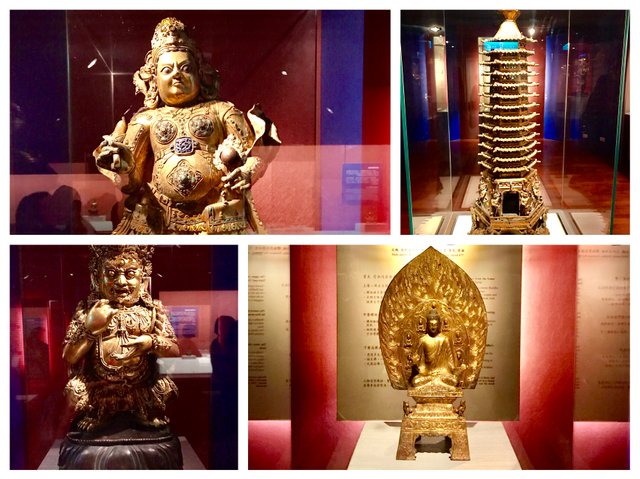
Mao Gong Ding
Like the Ding Vessel we saw outside the main building, this "Ding" is from 9th century BC. It is significant because it has the longest Chinese inscriptions of any Ding ever made, 500 to be exact. If you look carefully, you can see that the characters are not the same as the ones we use today, of course in the 9th century BC, the characters looked closer to their original bone script pictograms. I must admit, I don't really understand most of the characters myself.
The big bell is the Zong Zhou Zhong or the Bell of Zhou. It is one of the most important musical instruments commissioned by King Li of the Zhou Dynasty.

Jadeite Cabbage
This is the star of the show, and the largest draw of all exhibits within the National Palace Museum. The cabbage is carved from a single piece of Jadeite which was half green and half white. If you look closely, you'll see the locust and katydid camouflaged in the leaves.
This along with the Mao Gong Ding and the meat shaped stone are considered the three treasures of the National Palace Museum.
I was quite surprised when I saw the piece in person. I was expecting it to be the size of an actual Chinese cabbage. I was mistaken, it's actually about the same size as my hand. The detail on the piece is very precise. Without looking carefully, you might mistaken the locust to be a real one. It's a very beautiful piece, and I think it deserves being the symbol of the museum.
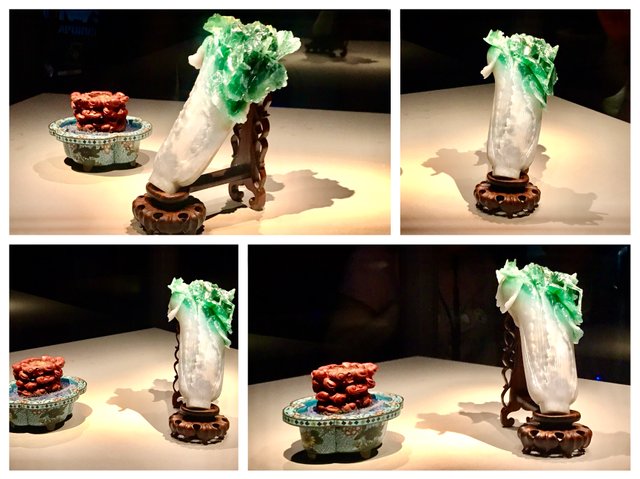
Meat Shaped Stone
The final piece in the trio of National Palace Museum is the meat shaped stone. For any Chinese food gastronomers, you will recognise this as a piece of braised pork belly meat. It is hard to believe that it is infact a piece of stone carved from from Jasper.
The stone dates back to the Qing dynasty and was a part of the imperial household's collection. Because of it's close resemblance to an actual piece of braised pork belly meat, it is often associated by the famous poet and gourmand, Su Dongpo. Actually he was attributed as being the inventor of the braised pork belly dish. To this day, the dish is often called Dongpo meat.
This along side the Jadeite Cabbage are touted as the most important items in the museum. Although popular, they are actually only of moderate importance with respect to art history. Still, the Meat Shape Stone along with the other two treasures are very well received and have a permanent display at the museum.
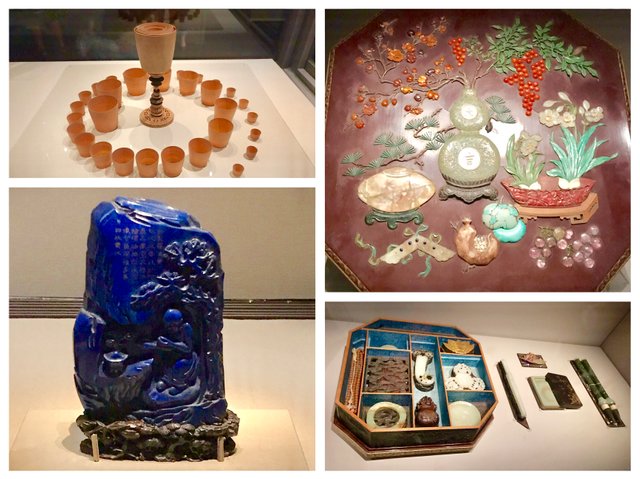
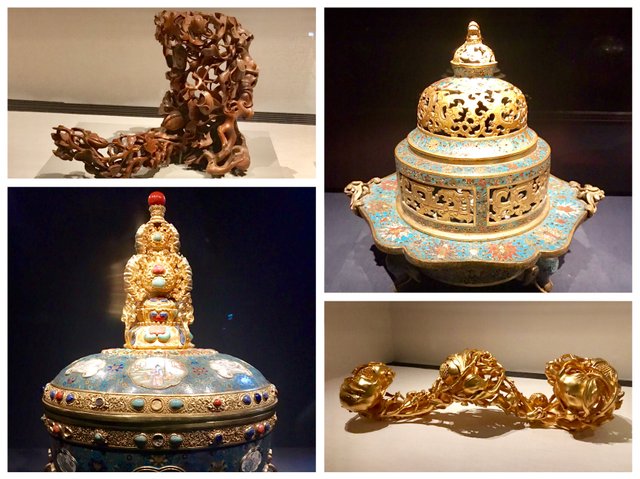

There was also a nice video exhibit of the evolution of Chinese writing from it's original oracle bone script etched on turtle shells and bones, to the Shang Dynasty's Greater Seal and so on... till today's Traditional and Simplified scripts.
Can you guess what the characters mean from their evolving pictograms? (Chinese people are disqualified!)
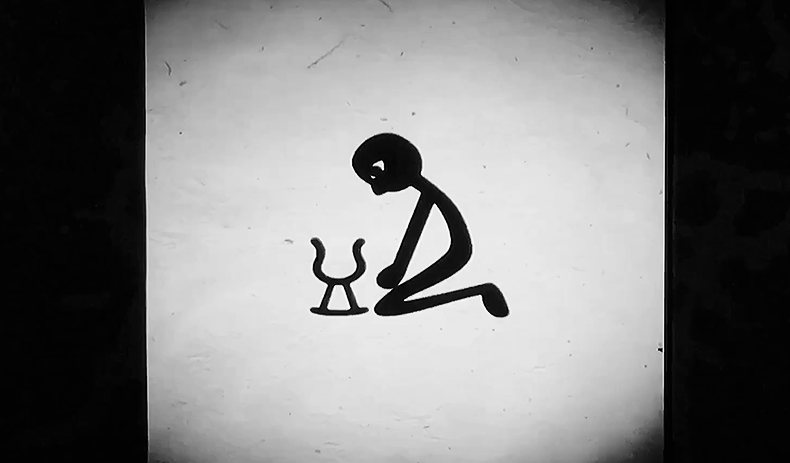
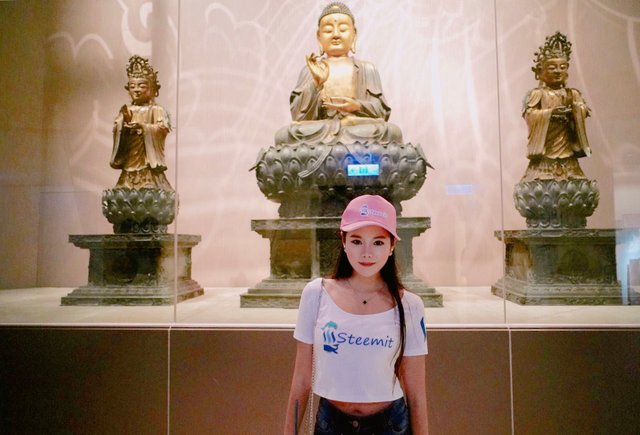
Check out my video tour!
And that wraps up the tour of the National Palace Museum in Taipei, Taiwan. For me, it was a significant visit because some of the history surrounding the museum was taught to me during my childhood. It wasn't until growing up that I really had an opportunity to think about the gravitas of the situation in China leading to the disbursement of its most prized treasures.
To the ignorant eye, many of the treasures here would appear to be no different from the mass produced that we see selling in souvenir shops, but let me remind you that many of these were crafted thousands of years ago by hand. Each taken a skilled craftsmen years of their life to complete. Many of the items would be considered their life's proudest achievement.
All things considered, it now makes sense to me why the collection has been under protection and indeed contention for the best of a century, without which, many would have been destroyed or lost. They are all important relics of a bygone era of Chinese dynastic rule.
The National Palace Museum is definitely worth a visit. Even if museums are not your usual fancy, there will be lots of fascinating bits of history to learn and of course many amazing ancient artifacts each with their own tale to tell.

有一个地方,让我对这次台北之行充满了期待。一直在心底碎碎念的,除了那一大波让人“醉生梦死”的美食,就是让我“魂牵梦萦”的台北故宫。用这个词些许有些夸张,但实际上我对台北故宫的好奇可不只一点点。为什么说中国是世界四大文明古国之一,只要走进两岸一边一个雄伟矗立着的故宫,答案立刻见分晓。小时候被父母带着,进去过北京故宫几次,印象最深刻的就是它那壮观建筑群所带来的强大气场。给了我极大的心灵震撼,每一件珍藏的历史文物都是这个民族文化发展和历史演变的见证,诉说了太多值得被铭记的故事。
几年前的某一天,从刚从台湾出差回来的爸爸嘴里,听到了对于台北故宫的描述,更有看头这四个字勾起我对于台北故宫无限的憧憬。这次有机会来到台北,刚刚歇脚几天的我,就决定马不停蹄赶往台北故宫,一览台北奇珍异宝的风采。现在就请大家和我一起走进台北故宫,探索一下这两个故宫有什么不同吧。台北故宫位于士林区,整体的外观是中国传统的皇家宫廷建筑,站在门口就能看见,黄绿白三色的建筑群被周边的青山绿树紧紧环绕,植被茂密,整个广场的设计风格清丽典雅,给人非常舒服的感觉。眼前的博物院聚集了中华文物的精华,收藏了各类文物珍宝大约有65万件,绝对是最有看头的博物馆了。
喜欢研究文物的朋友,大概可以看上好几天了。只可惜我的时间有限,所以只能走马观花,看个大概。尽管这样,馆内文物的精美华丽程度还是让我大开眼界,它们留在我脑海里的印象,成为了这趟台北之旅最意想不到的惊喜。馆内文物的来源大多是抗日战争时期,由于当时的北京形势严峻,国民政府决定挑选北京故宫博物院、古物陈列所、颐和园和国子监的重要文物一齐撤离北京,向南迁徙。同时藏品中还有抗日战争胜利后,向日本索要回的不少珍贵的古籍和艺术品。如今的故宫博物院每三个月都会固定更换展品,有时候还会有特别的展览,所以这么多年,慕名而来的文物爱好者,络绎不绝,对他们来讲,台北故宫里的万千种文物是百看不厌的。连台北故宫博物院老院长秦孝仪都说:中国之美,美在文化艺术,文化艺术之美,尽在故宫。
一走进博物院的大门就看到孙中山先生的塑像。头顶上的博爱二字据说是孙中山最喜欢的两个字,他常常将这两字送人,博爱二字同样也是他一生最好的概括和写照。接下来就去馆内探个究竟吧。这是我第一次见识到这些传世珍宝是如何让现代人不停惊呼,啧啧称奇的。其中让我印象最深的,就是这两大镇馆之宝,一个是西周的毛公鼎,这是清道光年间在陕西省出土的文物,它的最大特色就是鼎内里刻下的铭文,不仅为后人提供了珍贵的历史资料,也在中国的文学书法艺术中占有举足轻重的地位。
另一个镇馆之宝当数清朝的翠玉白菜。这颗白菜一直是台北故宫里的超人气明星,来来往往的游客一进故宫,都会迫不及待的找寻白菜的踪影,感觉看过了翠玉白菜才不虚此行。想拍到这颗明星白菜可真不容易,展品前挤满了前来观赏的游人,目不转睛的盯着这颗玉石不舍得离去。说这颗白菜传奇,并不是没有原因的。这颗玉石有着世间少有的颜色分布,当年玉雕师就是用这自然天成的色彩分布,雕琢出了一颗惟妙惟肖,鲜嫩欲滴的白菜。翠玉白菜是清朝永和宫的陈设器,传说是光绪的妃子瑾妃的嫁妆之一。白菜象征着清白纯洁,仔细看翠绿的叶片上,还爬着两只象征多子多福,栩栩如生的螽斯,精妙绝伦的工艺实在让人忍不住拍手叫好。直到走出故宫,我还深深沉浸在文物所带来的历史熏陶中,久久不能自拔。关于这两个故宫,谁更胜一筹,最终还是找到了答案。北京故宫拥有气势恢宏的宫廷建筑,而台湾故宫则拥有美妙绝伦的稀世珍宝,二者各有千秋,缺一不可,如果把二者合在一起,那才是珠联璧合,人们心中最完美和完整的故宫。今天的故宫之行就到这里了,之后还有更多精彩的游记想要分享给大家。
As the young lady that you are, I feel inspired by what you do. I want similar experiences with this steemit platform. Thank you for sharing.
Thanks javybar, just remember to enjoy the journey and keep going!
I am always happy to read and to see your beautiful blogs and picture, thank you so much @sweetsssj for another perfect blog and I am happy that you always safe while your travelling around the world. keep it up and congratulation again for this great article.
chinese girls are very charming..
Excellent advice. I will really take it into account. Thanks
want similar...check out the awesome majesty of the Northern Lights.... https://steemit.com/photography/@godfatherofsalsa/the-northern-lights-aurora-borealis-castles-and-lighthouses-north-east-england
good...one
haha i'm gonna need a go pro
#shred
wow, i love these kind of places!
I never took you for the museum type dear!
not exactly museum type, but i like these kind of places :D
A fascinating tour of the The National Palace Museum in Taipei, Taiwan, @sweetsssj.
First, let me congratulate you on the quality of the writing in this post - it is some of your best work.
The photo spread was visually stunning and comprehensive featuring exquisite and priceless treasures. I especially loved the Jade pieces.
You also did an excellent job of providing the historical perspective so readers and potential visitors could appreciate the significance of the collection both culturally and historically, and you managed this by being non-partisan and fairly representing the interests of both sides.
It is the mark of an educated person to utilize one's education to gain an insight into society, but you also rose above the deficiencies of a certain limited viewpoint of recent history that you were taught in China, and that is a tribute to your objectivity, sssj.
I was impressed with the locale of the museum. It was built with the same architectural principles in mind as one sees in traditional temples. It was built into a hillside, a high place, with stairs leading up to it, and mountains in the background.
The presence of lions as guardian entities and the Huabiao with the cloud and the lion atop it contribute to evoking the sense of a religious dimension in an otherwise secular setting.
I found the part on the evolution of Chinese script fascinating. I can recall taking books out of the library when I was in grade three and trying to figure out Chinese writing.
The two characters depicted reminded me of child-rearing and animal care, but that might be my own curious imagination, lol.
Your photo essay reignited my fascination with ancient China and the intrigue of the past. It made me want to visit Taipei and China too, for that matter.
I find you are able to make history and culture come alive,sssj, and that is what makes your posts so effective and compelling.
Excellent work, my friend.
Hi john, thank you for this lovely value adding comment! What would my posts be without your eclectic reviews of it. Mmmm.
As you pointed out, remaining objective was quite difficult. Especially with an audience of whom I know will likely be not as objective as I, wondering why it is I couldn't jump off the fence and side with them. Still, I feel it is a worthwhile exercise for the sake of trying to uncover or understand the residual truth(s).
One thing that I didn't quite manage to cover was the large amount of art works which are on rotation every 3 months or so. It actually makes up the larger part of their 700,000 item collection. I would have liked to include these in the post but i simply ran out of time and didn't have another day to come back. With such a large museum, it's always worth a revisit.
As for the characters, you are very close. Care is actually the first character. The second is a lot more abstract, I will see if anyone else can think of it :)
Thank you for the lovely comment john, I always appreciate it.
You're very welcome, sssj - hmmm, something more abstract? I'd guess helpless things, like babies and animals, so maybe care for Life....You are going to tell us poor westerners, aren't you? LOL!!
Wao So Great
I Followed You & did Upvote Now Do Same Visit To My Posts.
Thanks
Your comment was downvoted by @miti on its content.. but don't worry because at this time I used only a small portion of my Steem Power percentage as a warning.
To write comment for asking vote for vote OR follow for follow is considered spam in Steemit community. I also suggest you to read Steemit etiquette carefully before you hurt your reputation.
If you keep tryin' and don't stop writing that kind of comments, I am forced to increase my Steem Power percentage to downvote your spam comments, hurting your reputation too.
I'm not a BOT and my aim is to clear posts by trolls and spammers.
Beautiful!!! Love your post and i followed you hope to see more from you. would love to get there some day. Headed to Thailand again this year. Check out my post I have some pictures from there
that's a great place to visit, i'm already missing it myself actually. I shall drop by and have a look.
i agree with u...
Wao So Great
I Followed You & did Upvote Now Do Same Visit To My Posts.
Thanks
从你的文章里看到的内容甚至比我亲自参观的时候看到的都要多。两年前去参观过,现在印象最深的就是人多,尤其是那棵白菜,排队的游客实在是太多了…
谢谢哟,我也是想尽力拍到更多,让大家欣赏到台北故宫强大的魅力,游客确实非常多,无论平日还是周末:)
Wow ! Amazing !!
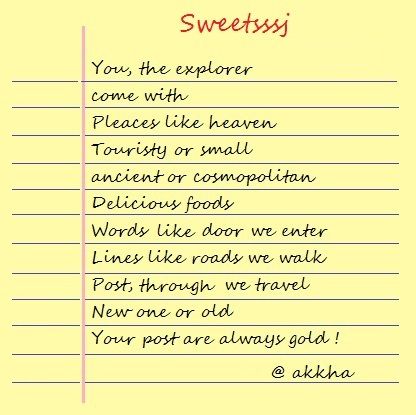
This one is for you @sweetsssj .
akkha, thank you :)
You are welcome my friend ! Just tried to make lines for you ! M too going to post on travel soon!👍 Always enjoy your post 👌😍🌷
Hello @sweetsssj ! 9 Days no post ! Hope you are doing well ! Waiting for your new post !!! Mssing you, your post , your reply and your ups !
歡迎來台灣:D
很高興看到妳玩的那麼開心喔!!!
谢谢啦,台湾真的很有的玩呢:)
而且很好吃,台灣食物太美好了嗚嗚不利於減肥(不
enjoy the Northern lights in England
“魂牵梦萦”的竟然只是故宫而不是刘美女 ;)
刘美女更重要啦,还是你懂,哈哈^^
It’s nice to c that the best travel blogger is on Steemit
Very beautiful pictures. You're travels are extraordinary!!!
i want also visit this place.
This post has received a 8.33 % upvote from @boomerang thanks to: @babarrajo
@boomerang distributes 100% of the SBD and up to 80% of the Curation Rewards to STEEM POWER Delegators. If you want to bid for votes or want to delegate SP please read the @boomerang whitepaper.
KICKASS !
https://steemit.com/brain/@kickassfacts/30-kickass-and-awesome-facts-about-brain-part2
I agree, I also want to visit this wonderful place. The photos are amazing! After reading this post I feel like I was on vacation with the author and saw these places by my own eyes.